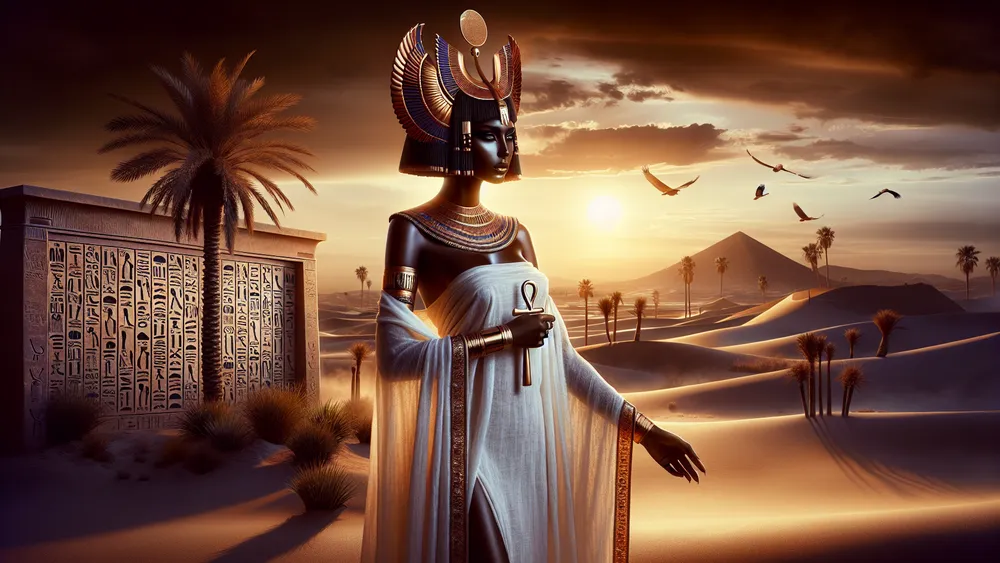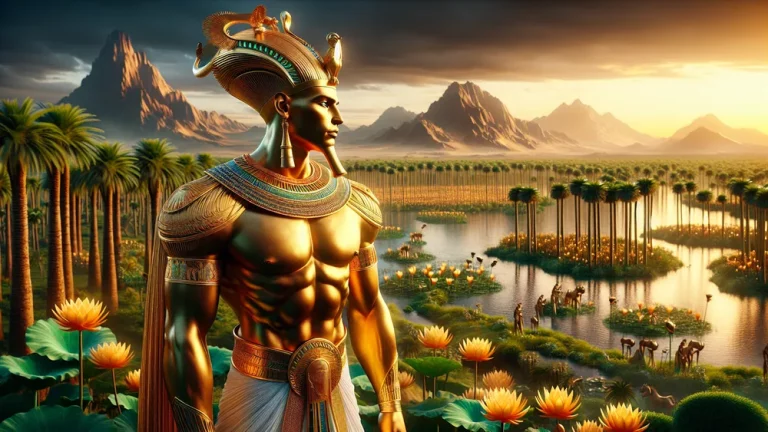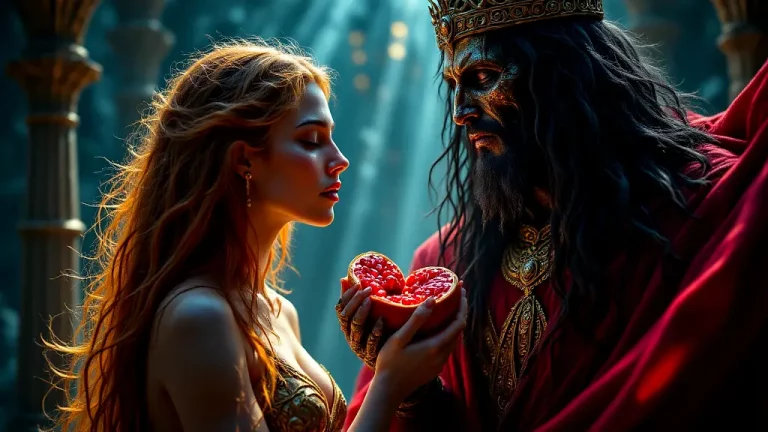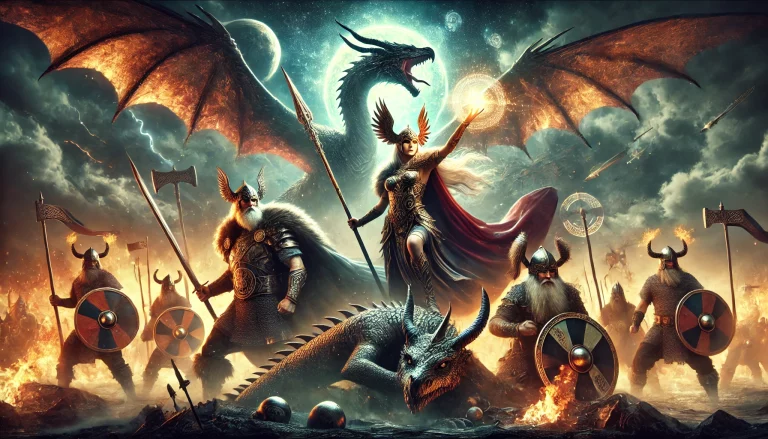Amentet: Egyptian Goddess Of The Dead And Land Of The West
Hello to our look into Amentet, an interesting person in old Egyptian stories. Amentet, sometimes called the “Goddess of the Dead” and the “Lady of the West”, has a big place in ideas about the afterlife. Think of her as a helper, like a person who keeps the light on at the edge of the sea, who assists spirits to move towards the afterworld.
Key Points:
- Amentet is an Egyptian goddess known as the Goddess of the Dead and the Lady of the West.
- She guides souls to the afterlife in the Land of the West, a paradise for the deceased.
- Amentet is featured prominently in ancient Egyptian texts like the Pyramid Texts and the Book of the Dead.
- In Egyptian art, Amentet is often shown as a woman with symbols of power and eternity.
- The Land of the West symbolizes the end of life and everlasting peace in Egyptian beliefs.
- Amentet’s role involves welcoming the deceased and leading them to their eternal resting place.
- Today, Amentet is still present in modern media and spiritual practices, reflecting a continued interest in Egyptian mythology.
This post will talk about many parts of Amentet’s story. We will start with where she came from and her background a long time ago. After that, we will check her part in ancient writings and stone images, what she has to do with the Land of the West, and how she helps the dead.
Also, we will look at how she is shown in old art and why the West mattered in Egyptian thoughts. Finally, we will see how Amentet is shown in new media and in today’s spiritual ways. By the end of this road, you will know a lot about Amentet’s spot in Egyptian stories and her lasting memory.
Amentet: Overview and Key Facts
| Key Point | Description |
|---|---|
| Name | Amentet (also called Ament, Imentet, or Amentit) |
| Title | Goddess of the Dead, Lady of the West |
| Role | Helps souls of dead people, welcomes them to the place after death |
| Symbolism | Stands for the western horizon, where the afterlife begins |
| Depictions | Often shown as a woman with a feather or a hawk on her head |
| Associated Realm | The Land of the West, place for dead souls that is like paradise |
| Historical Texts | Said to be in Pyramid Texts, Coffin Texts, and the Book of the Dead |
| Cultural Importance | Shows the change from life to death, a big part of Egyptian ideas |
| Seen Today | Shown in today’s media and spiritual activities |
The Beginnings and Importance of Amentet
To really know about Amentet’s part in Egyptian stories, we have to first look at where she started and the importance she had in old ideas about the afterlife.
Historical Background of Amentet
Amentet, whose name means “She of the West,” came from old Egyptian myths and was linked to the place where the sun goes down and the afterlife starts. Think of her like someone who welcomes you at the door of a big, never-ending feast, helping guide souls to where they stay forever.
In Egyptian ideas about what happens after death, she had a big part in making sure the dead were taken to the Land of the West, a paradise where they could live forever. Her importance is shown by her many mentions in ancient writings and tomb pictures, where she is often seen greeting the dead. Some main parts of what she did include:
- Welcoming the Deceased: She met souls when they got to the afterlife to make sure they were let into the Land of the West.
- Symbol of Change: Amentet stood for the shift from being alive to being dead, showing the path every soul has to take.
- Protector of the West: Since she was the Lady of the West, she was closely tied to the western horizon, a holy direction in Egyptian culture.
Amentet played a crucial role in ancient Egyptian beliefs by welcoming the deceased into the afterlife, symbolizing the transition from life to death, and protecting the Land of the West.
Amentet in Old Texts and Carvings
Amentet shows up a lot in old Egyptian writings, which shows how important she was in their beliefs about religion. The Pyramid Texts, some of the oldest religious writings, date to the Old Kingdom time, and they talk about Amentet. These writings were put on pyramid walls meant to protect kings after they died.
Amentet is shown as someone who meets the dead and makes sure they get safely to the Land of the West. Also, the Coffin Texts from the Middle Kingdom talk about Amentet. These writings were put on coffins to guide dead people through the afterlife with spells.
The Book of the Dead, from the New Kingdom, is a bigger collection of writings for funerals and mentions Amentet a lot. This book, filled with pictures, was made to help dead people get through the afterlife and live forever. Amentet is often shown in these pictures, proving she was a guide and protector of dead souls. Her presence in these important writings shows how long-lasting her role was in Egyptian stories. Important writings mentioning Amentet include:
- Pyramid Texts: Old Kingdom writings on pyramid walls.
- Coffin Texts: Middle Kingdom writings on coffins.
- Book of the Dead: New Kingdom funeral writings with pictures.
Amentet’s Part in the Afterlife
To completely understand Amentet’s role, it’s important to explore what she does and the area she controls in the afterlife.
The Land of the West: Amentet’s Realm
In old Egyptian stories, the Land of the West, also called the Duat, is seen as a perfect place where dead people can have endless life. Think of it like a calm, forever garden where souls are happy after they finish their time on earth. This place is in the west where the sun goes down, showing the end of the day, and this stands for the end of life.
Amentet, whose name means “She of the West,” is closely tied to this holy place. She works as the one who looks after it and leads souls, greeting the dead and making sure they get safely to this endless paradise. Her part is very important because, without her, souls might not make it to the Land of the West. Key parts of the Land of the West and Amentet’s link to it include:
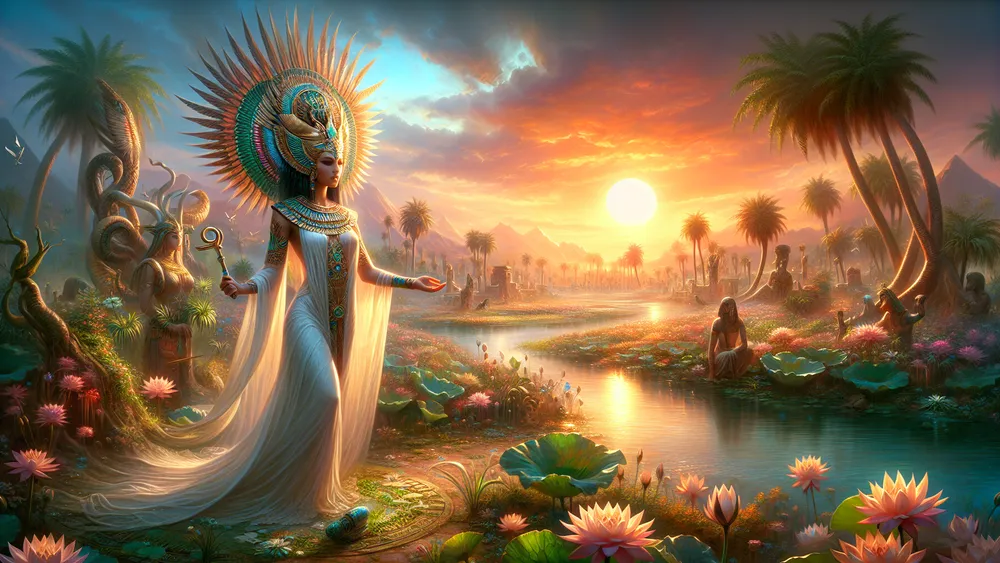
- Final Resting Place: The Land of the West is the ultimate end for souls, like a heavenly paradise.
- Symbolism of the West: The western horizon stands for the end of life, making it a fitting place for the afterlife.
- Amentet’s Role: As the watcher of this place, Amentet makes sure souls are greeted and led to their endless home.
Amentet as a Helper for the Dead
Amentet’s main job is to lead dead people’s souls to the afterlife and make sure they are greeted in the Land of the West. Think of her like someone who welcomes guests, meeting each soul at the door of forever and making them feel comfortable as they move from the world of the living to the next place.
She is often shown standing at the tomb openings or the west horizon, showing she is the first person the dead see. Her being there is very important because she not only meets the souls but also makes sure they are allowed into the afterlife, which includes different rituals and ceremonies.
When looking at Amentet’s job compared to other gods in the afterlife journey, each one has its own special job. For example, Anubis, the god with a jackal head, takes care of embalming and protecting the dead, leading them through the underworld. Osiris, god of the afterlife, rebirth, and plants, runs the final judging of souls, deciding their future.
Ma’at, goddess of truth and fairness, makes sure the hearts of dead ones are checked against the feather of truth to see if they are pure. Though Amentet’s job is more about greeting and leading, these other gods have key roles in getting ready, judging, and checking the morals of the souls. Here’s a comparison of their jobs:
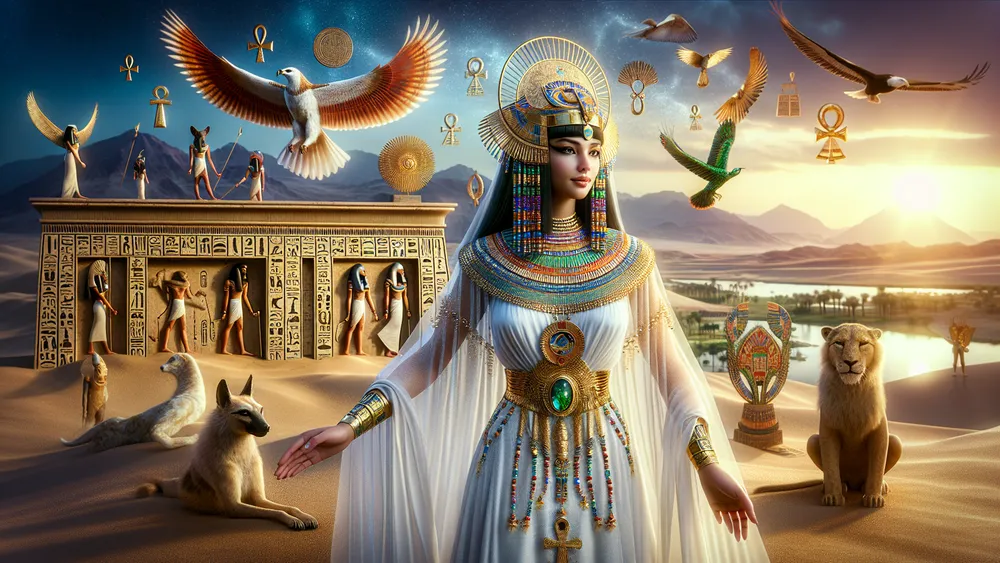
| God | Work in the Afterlife Journey |
|---|---|
| Amentet | Meets and leads dead souls to the Land of the West |
| Anubis | Prepares and protects the dead, leads them through the underworld |
| Osiris | Runs the final judging of souls |
| Ma’at | Checks the hearts of the dead against the feather of truth |
Amentet’s Images and Symbols
To understand why Amentet matters, it’s important to look at how she shows up in old art and the symbols linked to her.
Pictures of Amentet in Old Art
In old Egyptian pictures, Amentet is often shown as a calm and inviting figure, being a kind of sky hostess. Usually seen as a woman, she wears a hat with the sign for “west,” showing her link to the Land of the West. Other times, she holds a stick and an ankh, the life sign, stressing her job in leading souls to endless life.
You might see her at the door of tombs or near the west horizon, which shows her job as the watcher of the afterlife. Common things linked to Amentet are:
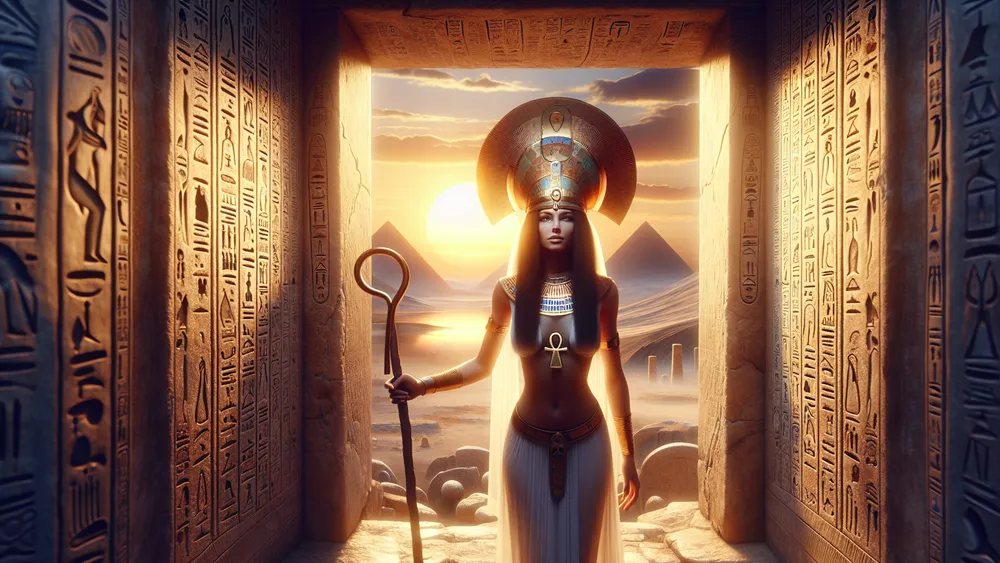
- Hat with the Sign for “West”: Shows her tie to the Land of the West.
- Stick: Stands for power and her job in leading souls.
- Ankh: Means life and living forever.
- Seen at Tomb Doors: Points to her job as the first one dead people see.
Amentet is a key figure in Egyptian mythology, symbolizing the guide to the afterlife with her hat, stick, ankh, and presence at tomb doors.
The Meaning of the West in Egyptian Culture
In old Egyptian ways, the West had deep meaning because it was linked to the sunset, marking the day’s end and, by extension, the end of life. This idea made the West a good match for the afterlife, where dead people would go for endless rest. Amentet, whose name means “She of the West,” shows this idea through her job and looks.
She is often shown with the sign for “west” on her hat, showing her link to this special place. Her job of leading souls to the Land of the West makes this connection even stronger. Think of the West as the last stop, like the end of a long trip, where one finds peace and rest. Key parts of the West’s meaning in Egyptian ways include:
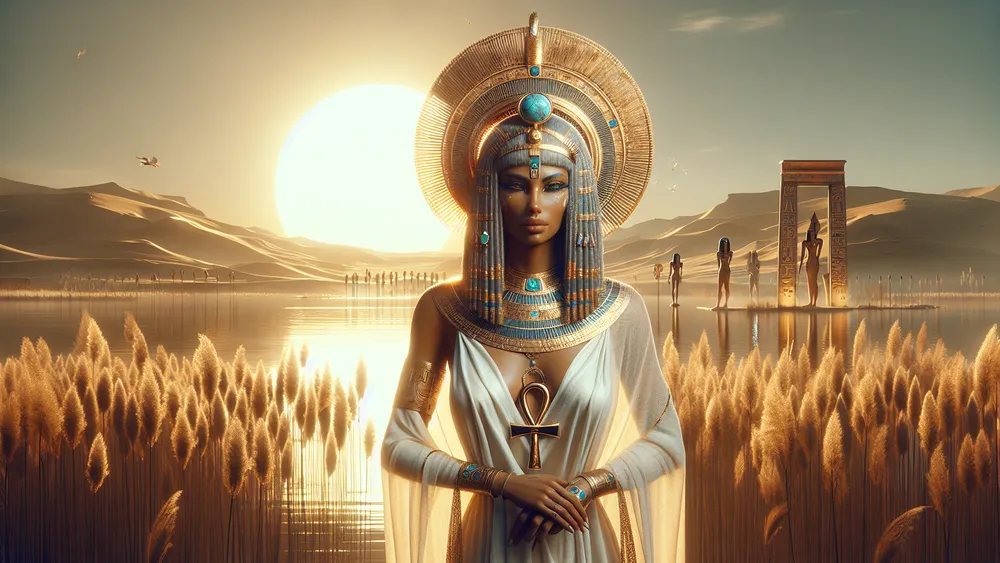
- Setting Sun: Shows the end of the day and life.
- Afterlife Picture: The West stands for the final rest spot for souls.
- Amentet’s Hat: Has the sign for “west,” showing her job.
- Soul Leader: Amentet leads the dead to their forever home in the West.
Amentet in Today’s World and Views
Now that we’ve looked at how Amentet was shown in old art and her symbols, let’s see how people think of her and show her today.
Amentet in Today’s Media
In media now, you see Amentet in many forms like books and movies and also video games, often shown as a mystery and magic figure. For example, in some made-up stories, she is shown as a keeper of the afterlife, leading souls just like in old times. In movies, she may be shown with big style, sometimes taking on a more dark or strong role to fit the story better.
Video games often use her as a figure who gives quests or help to players, mixing old-time facts with new storytelling. But, these versions often take creative freedoms, sometimes changing her looks or features to fit what people like now. For example, while old-time pictures show her with a hat having the mark for “west,” new media might make this with more fancy designs. Important parts of Amentet’s showing in today’s media include:
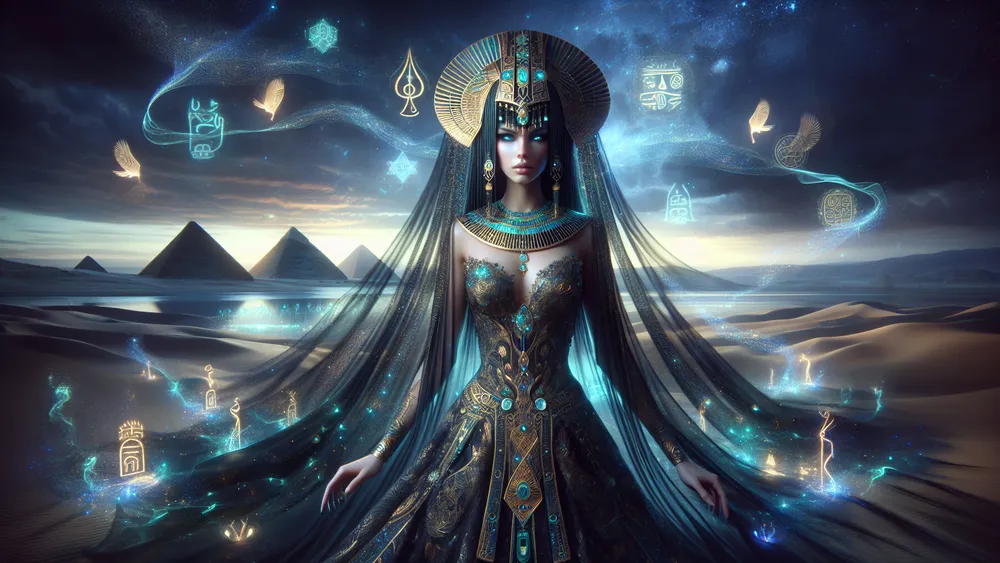
- Books: Often shown as a keeper of the afterlife.
- Movies: Sometimes shown with big and strong features.
- Video Games: Used as a figure giving quests or help.
- Creative Changes: New versions may change her looks or features for big effect.
Modern Devotion and Interest in Amentet
In our time, Amentet has found a place in different religious and spiritual ways, especially among those who like old Egyptian traditions. Some people today set up spaces for Amentet, doing prayers and rituals to ask for her help with things about the afterlife and spiritual changes.
This new interest in Amentet is part of a larger trend where old Egyptian gods are now liked in modern spiritual ways. People are often drawn to the deep meaning and great wisdom these old figures have. For instance, similar to how someone might turn to a guardian angel for help, followers might seek Amentet’s aid in dealing with life’s changes. Important parts of modern devotion to Amentet include:
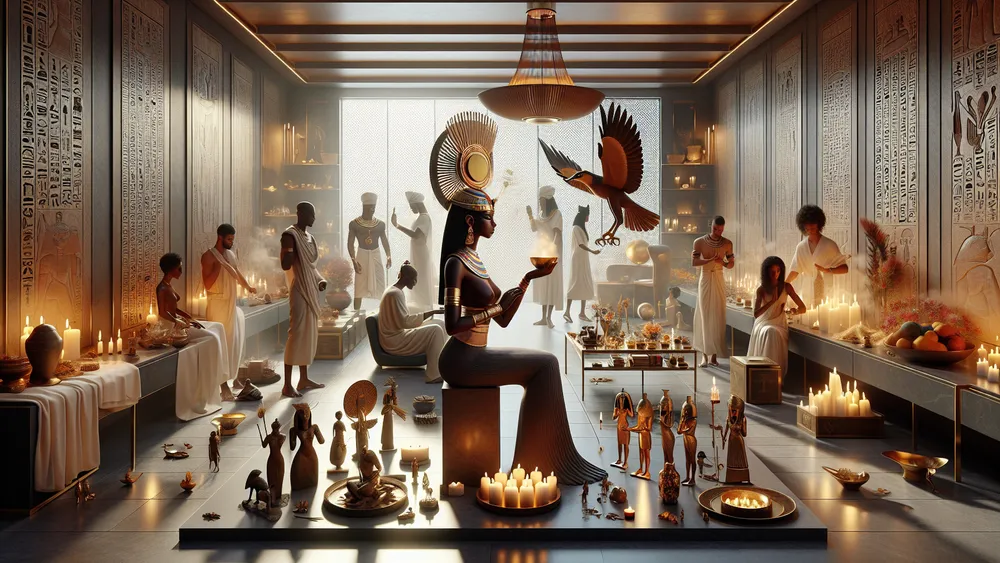
- Spaces and Prayers: Creating special places for prayers and rituals.
- Spiritual Help: Asking her for help with the afterlife and changes.
- Bigger Trend: Part of a growing interest in old Egyptian gods.
- Meaning and Wisdom: Attracts those drawn to old spiritual ways.
Egyptian Mythology: The Bigger Picture
In Egyptian tales, there is a rich mix of gods and goddesses, each with their own special roles and stories. Amentet, as the goddess of the Land of the West, has a key place in afterlife, leading souls to rest. She works with other gods like Osiris, who is the god of the afterlife, and Anubis, who is the god of mummifying and the dead, making a complex group of godly ties.
To see where Amentet fits in this detailed group, it’s good to look at the larger frame of Egyptian stories. For a full view, you can check out this list of all the Egyptian gods, which gives detailed facts on each god and what they mean.
This linked web of gods and goddesses shows the old Egyptians’ deep beliefs about life, death, and life after death.
FAQs
1. Who is Amentet in Egyptian mythology?
Amentet in Egyptian mythology is the goddess associated with the Land of the West and the afterlife.
2. What is the Land of the West in Egyptian beliefs?
The Land of the West in Egyptian beliefs is considered the realm of the dead where souls journey after death.
3. How is Amentet depicted in ancient Egyptian art?
Amentet is depicted in ancient Egyptian art as a woman wearing the hieroglyph for “west” on her head, often standing at the entrance to the underworld.
4. Are there any modern practices involving Amentet?
Modern practices involving Amentet include contemporary spiritual rituals and devotions that draw inspiration from ancient Egyptian mythology.

